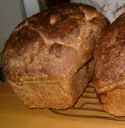
………Although I live in Scotland I’m a born and bred Derbyshire lass and there’s one thing that’s dear to my heart that is common to both places.
Oatcakes. Except that’s two things because they’re very different, of course.
Scottish oatcakes are small crunchy biscuits that are eaten with anything from cheese to soup, or even on their own. One of the first people I became friends with, when I moved up here, would put a pan of water on to make tea (no kettle) and put a wooden plate (he was a wood worker) of oatcakes on the table, as soon as anyone walked in. We had long conversations and I learned a lot about the area and its fauna and flora from him, over cups of tea and oatcakes.
Derbyshire oatcakes are, by contrast, almost dinner plate sized, soft pancake-type goodness. They too evoke wonderful memories of my Dad making us breakfast of bacon, egg and delicious crisp edged oatcakes, all fried in lard. Not fashionable these days, perhaps, but so tasty. (That probably gives a clue to my age). But don’t worry, they taste good cooked in oil too. And before surrounding areas get upset, Staffordshire oatcakes are similar and other areas may also make them. But I’m a Derbyshire lass – did I mention that?
Despite their very different qualities they’re made from the same ingredients, in only slightly different proportions. I’m totally amazed that regions, separated by only a few hundred miles, can use the same ingredients to such different ends. I’d love to know what other countries make with them.
I make both with my leftover 100% hydration sourdough starter (but don’t tell the neighbours – I’ll probably get drummed out of town). Both, in my humble opinion, taste brilliant using the slow method dictated by sourdough. It allows, or even encourages, the full flavour of the spelt (or whatever other flour is used) and oats to develop – so much tastier than those you buy. And they’re so much easier to digest and use up most of my leftover starter. So thrifty, healthy and tasty – how good is that?
There’s one other thing that may not be quite traditional (to the Scottish oatcake anyway) – I use porridge oats. I only buy porridge oats these days because I’ve thrown away more oatmeal that’s gone off than I care to mention and you may remember I don’t like throwing food away. I don’t like the texture of it in porridge and for some reason I always forget to use it in baking, reaching, instead, for the porridge oats. So I stopped buying it.
So, how to make these oaty delights. The exact proportion of ingredients needn’t be exact – these are both very old recipes that would have been made long before scales or cup measures, they’d have been made with a handful of this and a pinch of that. I read somewhere that Highlanders carried a bag of oats with them on their travels and would mix them up with a little water and bake them on a stone by the fireside. So don’t get hung up if you’re a bit short of something, as long as the consistency is right. I forgot to mention that, with both these recipes, I use sourdough for its flavour and acidic property when soaking the grain rather than its leavening properties, so if you’re not ready to use it immediately after feeding it’s no problem just keep it in the fridge, covered.
I’ll start with the Derbyshire Oatcakes because they’re the first in my heart. These are made with roughly equal quantities of sourdough starter, oats, water and spelt (or other flour). I usually just use a cup of each. I don’t worry too much about getting the right consistency at this point because the batter needs to be left overnight, covered, at room temperature. The next morning I add some melted butter (or oil if our gal is eating with us) – about ¼ cup or slightly less, a pinch (½ tsp?) of salt and the same of bicarb (baking soda). You may need to add a little more water (or milk if you like) to give the consistency of pancake batter – surprise!
From then on it’s just like making pancakes – hot pan, a little oil or butter and roughly ¼ -1/3 cup of batter swirled round the pan. (Don’t have the pan too hot because they’re going to be cooked twice so you don’t want them too brown.) Flip them and cook on the other side then put on a plate and leave to cool. Repeat with the rest of the batter. They freeze brilliantly – I used to separate them with a bit of greaseproof paper but I’ve found that if you defrost them thoroughly they don’t really stick to one another so I don’t bother now. Unfortunately I haven’t found any way round using plastic freezer bags though.
To serve simply fry them in a little oil or butter (or lard!) until heated through and a bit crispy round the edges. You can have them like pancakes with jam or lemon/sugar or whatever you like but there’s nothing better than as part of a breakfast fry-up.
I make Scottish oatcakes a little more precisely but that’s probably more down to a lack of confidence on my part. When I first started making them I tried out several different recipes then cobbled together the bits I liked from some of them, converted it to sourdough, and it became my version of a Highland Oatcake.
Mix porridge oats and starter with sufficient very hot (but not boiling) water to make a stiff dough (be careful – hot dough!) – again I use about a cup of each but only about half the amount of water. Knead about ¼ cup of melted butter or oil into the dough then cover and leave overnight, at room temperature. The next day the dough will very likely be solid, but that’s OK. Add a pinch of both salt and bicarb and crumble up the dough adding sufficient water to get it back to a pliable dough – a tablespoon at a time until you get the desired consistency. Knead it well, roll out on a lightly floured surface to about 3-4mm thick and cut out with a cutter or into triangles.
I bake them at 180C for about 25-30 minutes. They might feel slightly soft still as they come out of the oven but they crisp up as they cool – if they don’t they’re very forgiving and can be bunged back in the oven for a few more minutes. I usually manage to get a couple of dozen oatcakes out of this but it depends on the size of cutter and I must confess to being rubbish at rolling out evenly so some are always thicker than others. Like I said they’re forgiving. They keep well for days in an airtight box and are lovely with soft cheese (Crowdie) or just about anything (or on their own with a cup of tea).
The eagle-eyed will realise I’ve not used all the 300g of leftover sourdough (a cupful is very roughly about 250g – no letters please lol). Sometimes I just chuck it all in and make a bit more of the batter or dough but at other times I make pasta. The amount left is roughly the size of an egg, and that’s exactly how I use it – to replace the egg. There are plenty of recipes elsewhere for making pasta so there’s no need to replicate them here but I do have a bit of a formula. I weigh the starter and count that as roughly ¾ of the weight of flour and double the weight of water. So, for example, if I have 50g of starter I need 67g (70s fine) and 25g water. Again I’d leave it to soak overnight before rolling out.
So that’s it. These are my favourite ways of using up my leftover sourdough but there are plenty of other recipes knocking about – just don’t throw it away!




Now I am twitching with excitement. I had your blog stashed nicely away in my RSS Feed Reader for quite some time but wondered why I never saw blog posts and it turns out that they weren’t being updated…I just deleted the old account, tossed you back into the mix and “voila” blog posts and WHAT blog posts! I am so excited about making these oat cakes (both kinds) and sourdough pasta? Where have you been all of my life! Lovely stuff and cheers for sharing with us how you use that awesome starter. Might be time to re-hydrate “Herman the horrible” and refresh him with some sprouted rice ferment water methinks. If you read about an explosion in Tasmania on the news, you know what happened 😉
Well I haven’t read of any earth tremors in Tasmania, so I’m hoping all went well. Keep watching there should be a couple more posts in this series.
My Nanna would cook oat cakes when she visited the farm when we lived in Wales.I have searched high and low looking for Derbyshire oat cakes and nothing. Living on our our farm in Queensland, Australia. I am going to give your recipe ago next fry up.
Smells and tastes can bring back such strong memories. I really hope you like them.